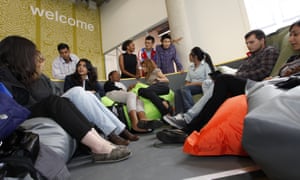
University campuses are intended as social spaces, yet their design often sends out the opposite message. Designers go for unusual shapes in an attempt to portray youth and vibrancy, but these can result in oddly proportioned spaces that are difficult to use. Bright colours, liberally splashed about to make areas seem lively, can feel jarring, and soon date.
Outdoor spaces can be just as problematic: think of all those walkways and squares across which students and staff march on their way somewhere else. Many are devoid of communal activity, o
vershadowed by buildings and lacking greenery. When budgets are tight, this is an area that often
Think about the in-between
The spaces between rooms need to provide a nurturing environment, rather than just a route from A to B. Fruitful conversations and encounters can take place where you might least expect them – on a staircase, in a lobby, at an entrance – so these areas to be welcoming.
Comfort shouldn’t be neglected: thermal, acoustic and ergonomic design can have a huge impact on physical and psychological well-being. Recent studies suggest that hospital patients with views of nature heal more quickly, that office workers with a window seat sleep an average of 46 minutes longer per night, and that doubling the supply of outdoor air to an office reduces short-term sick leave by 35%.
Get in-between spaces wrong at a university, and it’s only a matter of time before students lose concentration and focus. Get them right, and you will create a calm backdrop to learning, leading to better engagement and interaction.
Focus on flexibility
Spaces that can be easily altered and reappropriated are invaluable in busy environments like universities.
The “well space” in the University of Sheffield’s school of architecture, for example, is one of my favourite locations. Because it is double height, and able to accommodate a wide variety of activities, it has become the physical and social heart of our department.
Students can pass in and through as they wish, sometimes participating, sometimes observing. It is particularly useful on open days where parents and prospective students can see first-hand how the ethos of the school manifests itself - the informality helps to break down traditional hierarchies and encourage interaction.
Lucien Kroll is an architect who understands the importance of making design truly social. Kroll proposes spaces that are loose-fit, flexible and allow occupants to take ownership in a fluid and incremental way. His seminal project la Mémé at the Catholic University of Louvain exemplifies this approach, operating as an antithesis to the shiny corporate aesthetic seen in many modern university buildings.
Plan for your community
A sense of community needs to be supported by the design of the buildings., but those who work in them need to follow through.
Even the best-designed and equipped spaces can be rendered useless by inappropriate timetabling, or restrictive health and safety regulations.
And if time is squeezed at the start and end of teaching sessions, the chance for informal congregation and discussion is diminished, reducing opportunities for beneficial exchanges.
Open up to the public
With the rise of social media and the ability to work and learn remotely, the boundaries of the campus now stretch far beyond the physical infrastructure. But there is no reason that the real estate itself should be available only to staff and students.
There is enormous potential to open up facilities to the public throughout the year. Universities can become real public buildings for exchange, collaboration and celebration in the same way that town halls, libraries and municipal buildings once were.
This altruistic offer to citizens would no doubt have positive repercussions in relation to engagement, impact, employability and widening participation. It’s an intergenerational opportunity that should be embraced by universities, a chance to allow all the inhabitants of a community (not just its students) to benefit everything an open campus has to give.
Tags
Education

